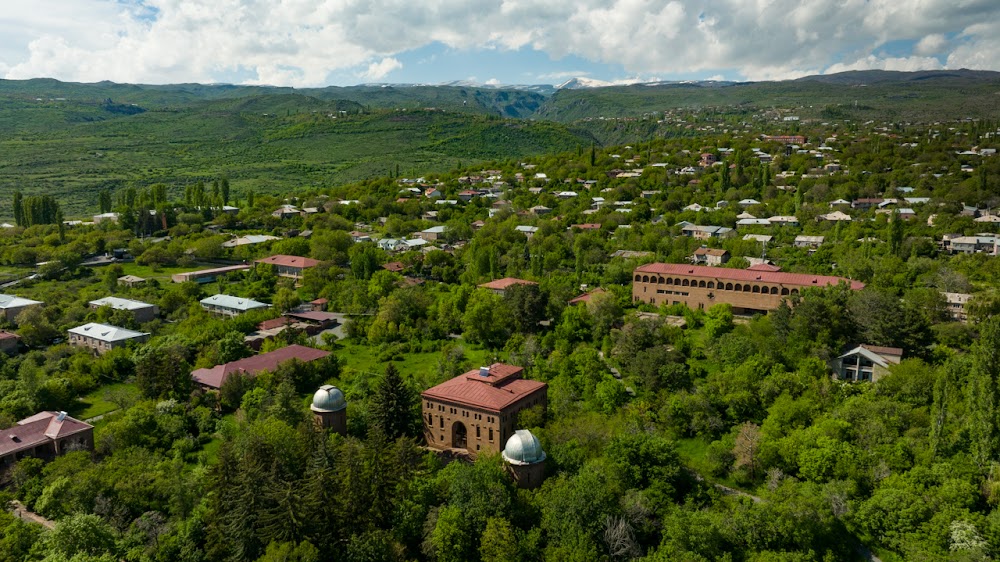Church of St. Astvatsatsin in Byurakan (Սուրբ Աստվածածին եկեղեցի)
Overview
The Church of St. Astvatsatsin, nestled in the charming village of Byurakan in Armenia's Aragatsotn Region, is a true gem of medieval Armenian architecture. With its serene ambiance and historical significance, this church attracts visitors from around the globe, eager to delve into the rich cultural heritage of Armenia.
Constructed in the early 11th century, St. Astvatsatsin—also known as the Church of the Holy Mother of God—stands as a remarkable testament to the intricate craftsmanship and deep spirituality of the Armenian people. Commissioned by the Pahlavuni princes, a notable noble family of medieval Armenia, this church has served as a spiritual hub for the local community for over a millennium.
One of the most captivating aspects of St. Astvatsatsin is its traditional Armenian architectural style. The church features a striking central dome—a hallmark of Armenian ecclesiastical architecture—symbolizing the heavens and the universe. Its exterior is adorned with finely detailed stone carvings and intricate cross-stones, known as khachkars, which illustrate religious motifs and Biblical scenes.
Inside, the church offers a tranquil and sacred atmosphere. The walls are embellished with faded frescoes and religious icons, inviting contemplation and reverence. The central altar, though simple, holds profound significance, serving as a space for quiet reflection and prayer. The gentle play of natural light filtering through the narrow windows creates a mystical quality that enhances the church's spiritual essence.
St. Astvatsatsin is not only a place of worship but also a symbol of Armenian resilience and faith. Throughout centuries marked by invasions and political turmoil, the church has withstood the test of time, embodying the enduring spirit of the Armenian people. During the Soviet era, when many religious sites faced persecution, St. Astvatsatsin remained a vital beacon of cultural and spiritual preservation.
Visitors to St. Astvatsatsin can also explore its stunning surroundings. The village of Byurakan is perched on the slopes of Mount Aragats, Armenia's highest peak, providing a breathtaking backdrop for the church. The mountainous landscape evolves with the seasons, offering mesmerizing views. Nearby, the Byurakan Observatory serves as one of the region's leading astronomical research centers, reflecting Armenia's significant contributions to science and exploration.
For history and archaeology enthusiasts, the Byurakan area is rich with ancient artifacts and historical sites. Close to the church, remnants of ancient fortresses and dwellings provide a glimpse into the lives of those who inhabited this region centuries ago. These historical treasures enhance the visitor experience, transforming a trip to St. Astvatsatsin into a captivating journey through time.
Another highlight of visiting St. Astvatsatsin is the chance to engage with the local community. The residents of Byurakan are celebrated for their warm hospitality, often inviting visitors to partake in local traditions and customs. Whether enjoying a cup of Armenian coffee, participating in a traditional festival, or simply strolling through the village, these interactions enrich the overall experience and offer deeper insights into Armenian culture.
In conclusion, the Church of St. Astvatsatsin in Byurakan is more than just a historical monument; it is a living testament to Armenian heritage, faith, and resilience. With its architectural splendor, historical significance, and the breathtaking natural scenery that surrounds it, this destination is a must-visit for anyone traveling to Armenia. As you walk through its ancient doors and explore its sacred spaces, you will not only witness the beauty of a bygone era but also feel the enduring spirit of a nation that has preserved its identity through centuries of change.




